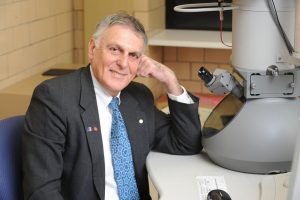
This event is free and open to the public. Light refreshments will be provided starting at 2:45 p.m.
Speaker: Dan Shechtman, Nobel Laureate and Iowa State University Distinguished Professor of Materials Science and Engineering
Title: Development of New Magnesium Alloys by Innovative Technologies
Abstract: During the past 25 years, Shechtman and his team have developed, made and tested strong rapidly solidified (RS) magnesium alloys for different applications. We have produced large number of alloys that contain zinc, zirconium and rare earth (RE) metals in small quantities. The idea to develop these alloys is based on stable Mg-Zn-Y quasi-periodic strengthening particles. This presentation summarizes the experimental work, illustrates new technologies we have developed to produce these alloys and the way the alloys were prepared. Also presented are different test results, including mechanical properties of these alloys. Several applications are detailed including biomedical and 3D printing.
Bio: Dan Shechtman earned his Bachelor’s of Science, Master’s of Science, and Ph.D. degrees at the Technion in Israel, in the field of Materials Engineering. He did postdoctoral work, supported by a fellowship from the National Research Council, at the Wright Patterson Air Force Base (USA) from 1972 to 1975. In 1975 he accepted a position as Lecturer at the Technion, and rose through the academic ranks there to become Distinguished Professor and to hold the Philip Tobias Chair. During his years at the Technion, he also held positions as visiting scientist at several U.S. institutions, including the National Institute of Standards and Technology (NIST). In 2004, he accepted a partial appointment at Iowa State University as a Professor of Materials Science and Engineering, and a position as Associate of the Ames Laboratory. In 2011 he was awarded the Nobel Prize in Chemistry for his discovery of quasicrystals. He made this discovery while working at NIST on April 8, 1982, and he championed it in the years that followed. This ignited a scientific revolution that changed the way we understand solid matter. His courage and clarity of vision during that turbulent, exciting period are an inspiration to scientists everywhere. He has won numerous other prizes for this achievement, including the International Award for New Materials of the American Physical Society (1987), the Wolf Prize in Physics (1999), and the European Materials Research Society’s 25th Anniversary Award (2008) — to name just a few.